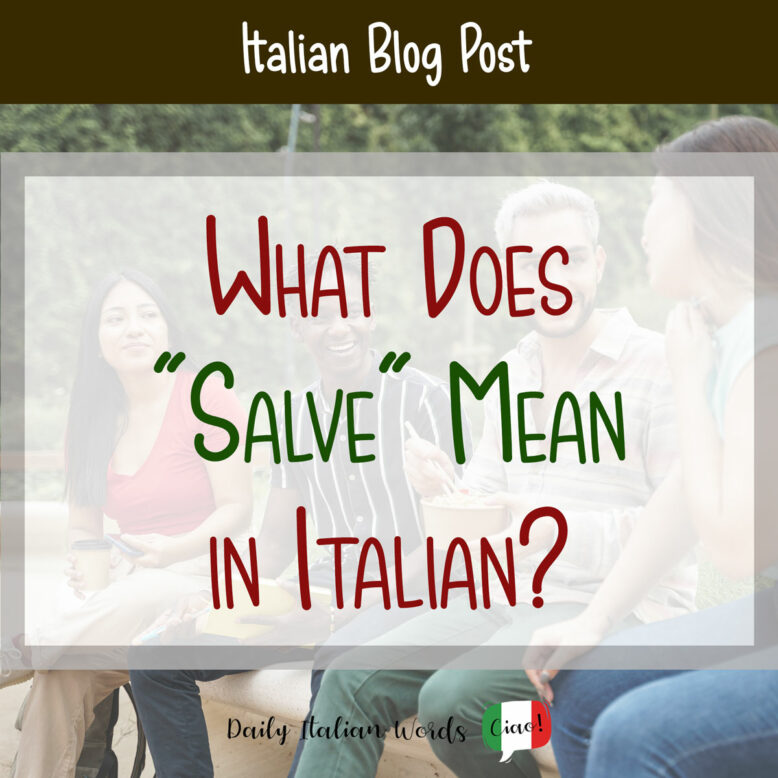Salve a tutti! Today we’ll talk about the chameleon of Italian greetings, one that fits in perfectly in any situation, at any time of day or night. Whether you’re paying for your groceries at the local market or greeting strangers on the street (yep, we’re that friendly in Italy), using salve in Italian is the perfect way to blend in like a local.
But don’t let its simplicity fool you. After all, there’s a certain degree of complexity to Italian greeting etiquette. While buongiorno is rather formal and ciao is super friendly, salve falls somewhere in between as a medium form of greeting that’s neither too stuffy nor too casual. Some people consider it a cold greeting, but that’s not the case at all. In fact, its origin is all about wishing good health!

Salve: From Latin roots to modern usage
The ancient Romans had a charming way of greeting others by saying Salve, which not only meant hello but also carried the wish for the other person’s good health and wellness. The word comes from the Latin verb salvēre, which means “to be in good health”. So, back then, whenever someone said Salve, they were essentially saying “Health to you!”. A beautiful message, right?
Over time, the word has evolved from its original etymological meaning to become a widely used generic greeting. Nowadays, we commonly use it on its own or in variations to greet multiple people, such as the cheerful salve a tutti (hello everyone) or the fun salve gente (hello folks).

How to use “Salve” in Italian
When greeting someone in Italian, there are quite a few nuances to consider based on the nature of your relationship with the person you’re addressing (Formal? Informal? Not sure where you’re at?), and the context of the situation (Are you meeting your in-laws for the first time? Or maybe you’re hitting the disco with a new friend?).
If you’re scratching your head about whether to use your formal or casual Italian, fear not – because there’s a greeting that suits pretty much any occasion: salve! This versatile word is ideal for various situations, from office meetings to encounters with strangers. Moreover, salve is an excellent choice when addressing a group of people with whom you have different levels of familiarity.
Here are some examples:
Salve a tutti, possiamo iniziare la riunione.
Hi everyone, let’s start the meeting.
Salve Professore, riconsegnerà le verifiche oggi?
Hi Professor, will you be handing back the tests today?
Salve ragazzi! Come va?
Hi guys! How are you?
But wait, there’s more! The time of day is another crucial aspect in Italian greeting etiquette. So, when you’re not sure if it’s too early to wish someone buonasera (good evening), just go with your trusty salve! However, keep in mind that using salve to bid farewell is less common. It is more appropriate to use arrivederci.
Also, if you’re wondering how to respond when someone greets you with salve, well, it’s best to simply say salve back. For example, if someone introduces themselves to you by saying Salve, piacere di conoscerla! (Hello, nice to meet you!), you can respond with Salve, piacere mio! (Hi, my pleasure!). Salve can have a friendly and approachable feel to it, making it a great choice for breaking the ice.
The versatility of salve doesn’t stop there. It is also used in religious context to open prayers like the Salve Regina addressed to the Virgin Mary (the Hail Holy Queen in English).

Difference between Ciao and Salve
Although ciao and salve basically have the same meaning, they are not really interchangeable. Ciao is the king of casual greetings. It’s the perfect way to say hello to your friends, family, or anyone you feel comfortable around. Picture this: you’re back from a day out with your friends and you shout Ciao mamma, sono tornata! (Hey Mom, I’m back!) – you don’t say Salve mamma, sono tornata (though it sounds pretty fun!).
Salve, on the other hand, is a bit more formal and the perfect way to show respect and professionalism to someone you don’t know well. Think doctors for example – you’d want to address them respectfully but without being overly formal, right? So instead of saying Ciao dottore, you might greet them with a polite Salve dottore.

Valentina is a travel writer in love with her country. Having travelled widely around the globe, she realised there was more to explore closer to home and decided to put the passport aside for a while. You can follow her adventures around Italy on her blog myitaliandiaries.com

Valentina Nicastro is a travel writer in love with her home country, Italy. Having travelled widely around the globe, she realised there was more to explore closer to home and decided to put the passport aside for a while. When she is not immersed in documenting Italy, you’ll find her donning her communication consultant hat, weaving words as a content writer and bridging linguistic divides as a translator.


